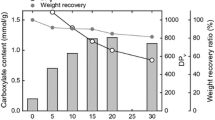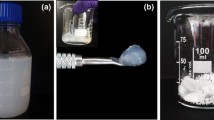Abstract
Never-dried sulfite wood pulp was beaten and subsequently microfibrillated before being submitted to periodate oxidation for various times. The oxidation progress, which was followed by 13C solid-state NMR spectroscopy in conjunction with degree of oxidation (DO) measurements together with ultrastructural observations, revealed that the cellulose crystallinity and microfibrillar integrity were kept intact until a DO of 0.3/0.4, indicating that at that level, the cellulose microfibrils had been oxidized exclusively at their surface. Beyond this DO value, the sample crystallinity started to deteriorate, as the oxidation progressed toward the core of the microfibrils. Remarkably, throughout the oxidation, the created carbonyl moieties were never observed, as they were readily recombined into hemiacetals by cyclization either within the same anhydro glucose unit (AGU) or with the adjacent un-oxidized AGUs of the same cellulose chain. At DO below 0.3/0.4, hemiacetal coupling with adjacent cellulose chains was also considered, but it appeared unlikely in view of the interchain distance imposed by the crystalline lattice. The oxidized samples were subjected to a reductive amination with benzylamine in order to convert their hydrophilic surfaces into hydrophobic ones. Despite the ease of this derivatization, the analysis of the 13C solid-state NMR spectra of the aminated products showed that, below a DO of 0.3, only half of the hemiacetal moieties could be converted into secondary amine products, whereas the other half remained untouched, likely for steric reasons.








Similar content being viewed by others
References
Araki J, Wada M, Kuga S (2001) Steric stabilization of a cellulose microcrystal suspension by poly(ethylene glycol) Grafting. Langmuir 17:21–27
Azzam F, Heux L, Putaux J-L, Jean B (2010) Preparation by grafting onto, characterization, and properties of thermally responsive polymer-decorated cellulose nanocrystals. Biomacromolecules 11:3652–3659
Berlioz S, Molina-Boisseau S, Nishiyama Y, Heux L (2009) Gas-phase surface esterification of cellulose microfibrils and whiskers. Biomacromolecules 10:2144–2151
Bragd PL, van Bekkum H, Besemer AC (2004) TEMPO-mediated oxidation of polysaccharides: survey of methods and applications. Top Catal 27:49–66
Brown RM Jr (1996) The biosynthesis of cellulose. J Macromol Sci Pure Appl Chem A33:1345–1373
Brumer H III, Zhou Q, Baumann MJ, Carlsson K, Teeri TT (2004) Activation of crystalline cellulose surfaces through the chemoenzymatic modification of xyloglucan. J Am Chem Soc 126:5715–5721
Casu B, Naggi A, Torri G, Allegra G, Meille SV, Cosani A, Terbojevich M (1985) Stereoregular acyclic polyalcohols and polyacetates from cellulose and amylose. Macromolecules 18:2762–2767
Cavaillé J-Y, Chanzy H, Fleury E, Sassi J-F (1997) Surface-modified cellulose microfibrils, method for making same, and use thereof as a filler in composite materials. PCT Int Appl, WO 9712917
Chanzy H (1990) Aspects of cellulose structure. In: Kennedy JF, Phillips GO, Williams PA (eds) Cellulose sources and exploitation. Industrial utilization biotechnology and physico-chemical properties. Ellis Horwood Ltd., Chichester, pp 3–12
Charreau H, Foresti ML, Vazquez A (2013) Nanocellulose patents trends: a comprehensive review on patents on cellulose nanocrystals, microfibrillated and bacterial cellulose. Recent Pat Nanotechnol 7:56–80
Elazzouzi-Hafraoui S, Nishiyama Y, Putaux J-L, Heux L, Dubreuil F, Rochas C (2008) The shape and size distribution of crystalline nanoparticles prepared by acid hydrolysis of native cellulose. Biomacromolecules 9:57–65
Filpponen I, Kontturi E, Nummelin S, Rosilo H, Kolehmainen E, Ikkala O, Laine J (2012) Generic method for modular surface modification of cellulosic materials in aqueous medium by sequential click reaction and adsorption. Biomacromolecules 13:736–742
Fumagalli M, Ouhab D, Molina-Boisseau S, Heux L (2013a) Versatile gas-phase reactions for surface to bulk esterification of cellulose microfibrils aerogels. Biomacromolecules 14:3246–3255
Fumagalli M, Sanchez F, Molina-Boisseau S, Heux L (2013b) Gas-phase esterification of cellulose nanocrystal aerogels for colloidal dispersion in apolar solvents. Soft Matter 9:11309–11317
Goussé C, Chanzy H, Cerrada ML, Fleury E (2004) Surface silylation of cellulose microfibrils: preparation and rheological properties. Polymer 45:1569–1575
Guthrie RD (1961) “Dialdehydes” from the periodate oxidation of carbohydrates. Adv Carbohydr Chem 16:105–158
Hasani M, Cranston ED, Westman G, Gray DG (2008) Cationic surface functionalization of cellulose nanocrystals. Soft Matter 4:2238–2244
Henriksson M, Henriksson G, Berglund LA, Lindström T (2007) An environmentally friendly method for enzyme-assisted preparation of microfibrillated cellulose (MFC) nanofibers. Eur Polym J 43:3434–3441
Herrick FW, Casebier RL, Hamilton JK, Sandberg KR (1983) Microfibrillated cellulose: morphology and accessibility. J Appl Polym Sci Appl Polym Symp 37:797–813
Heux L, Dinand E, Vignon MR (1999) Structural aspects in ultrathin cellulose microfibrils followed by 13C CP-MAS NMR. Carbohydr Polym 40:115–124
Heux L, Chauve G, Bonini C (2000) Nonflocculating and chiral-nematic self-ordering of cellulose microcrystals suspensions in nonpolar solvents. Langmuir 16:8210–8212
Hieta K, Kuga S, Usuda M (1984) Electron staining of reducing ends evidences a parallel-chain structure in Valonia cellulose. Biopolymers 23:1807–1810
Hirai A, Horii F, Kitamaru R, Tsuji W (1990) CP/MAS carbon-13 NMR study of never-dried cotton fibers. J Polym Sci Part C Polym Lett 28:357–361
Hou QX, Liu W, Liu ZH, Bai LL (2007) Characteristics of wood cellulose fibers treated with periodate and bisulfite. Ind Eng Chem Res 46:7830–7837
Ishak MF, Painter T (1971) Formation of interresidue hemiacetals during the oxidation of polysaccharides by periodate ion. Acta Chem Scand 25:3875–3877
Jackson EL, Hudson CS (1937) Application of the cleavage type of oxidation by periodic acid to starch and cellulose. J Am Chem Soc 59:2049–2050
Jackson EL, Hudson CS (1938) Structure of the products of the periodic acid oxidation of starch and cellulose. J Am Chem Soc 60:989–991
Kasai W, Morooka T, Ek M (2014) Mechanical properties of films made from dialcohol cellulose prepared by homogeneous periodate oxidation. Cellulose 21:769–776
Kim U-J, Kuga S, Wada M, Okano T, Kondo T (2000) Periodate oxidation of crystalline cellulose. Biomacromolecules 1:488–492
Klemm D, Kramer F, Moritz S, Lindstrom T, Ankerfors M, Gray D, Dorris A (2011) Nanocelluloses: a new family of nature-based materials. Angew Chem Int Ed Engl 50:5438–5466
Koyama M, Helbert W, Imai T, Sugiyama J, Henrissat B (1997) Parallel-up structure evidences the molecular directionality during biosynthesis of bacterial cellulose. Proc Natl Acad Sci USA 94:9091–9095
Larsson PT, Westlund PO (2005) Line shapes in CP/MAS 13C NMR spectra of cellulose I. Spectrochim Acta Part A 62A:539–546
Larsson PA, Gimaaker M, Waagberg L (2008) The influence of periodate oxidation on the moisture sorptivity and dimensional stability of paper. Cellulose 15:837–847
Larsson PA, Berglund LA, Wagberg L (2014) Highly ductile fibres and sheets by core-shell structuring of the cellulose nanofibrils. Cellulose 21:323–333
Lavoine N, Desloges I, Dufresne A, Bras J (2012) Microfibrillated cellulose—its barrier properties and applications in cellulosic materials: a review. Carbohydr Polym 90:735–764
Liimatainen H, Visanko M, Sirvio JA, Hormi OEO, Niinimaki J (2012) Enhancement of the nanofibrillation of wood cellulose through sequential periodate-chlorite oxidation. Biomacromolecules 13:1592–1597
Lindh J, Carlsson DO, Stromme M, Mihranyan A (2014) Convenient one-pot formation of 2,3-dialdehyde cellulose (DAC) beads via periodate oxidation of cellulose in water. Biomacromolecules 15:1928–1932
Ljungberg N, Bonini C, Bortolussi F, Boisson C, Heux L, Cavaillé JY (2005) New nanocomposite materials reinforced with cellulose whiskers in atactic polypropylene: effect of surface and dispersion characteristics. Biomacromolecules 6:2732–2739
Ljungberg N, Cavaillé JY, Heux L (2006) Nanocomposites of isotactic polypropylene reinforced with rod-like cellulose whiskers. Polymer 47:6285–6292
Maekawa E, Koshijima T (1984) Properties of 2,3-dicarboxy cellulose combined with various metallic ions. J Appl Polym Sci 29:2289–2297
Maekawa E, Koshijima T (1991) Preparation and structural consideration of nitrogen-containing derivatives obtained from dialdehyde celluloses. J Appl Polym Sci 42:169–178
Maia J, Carvalho RA, Coelho JFJ, Simoes PN, Gil MH (2011) Insight on the periodate oxidation of dextran and its structural vicissitudes. Polymer 52:258–265
Mazeau K (2005) Structural micro-heterogeneities of crystalline Iβ-cellulose. Cellulose 12:339–349
Montanari S, Roumani M, Heux L, Vignon MR (2005) Topochemistry of carboxylated cellulose nanocrystals resulting from TEMPO-mediated oxidation. Macromolecules 38:1665–1671
Moon RJ, Martini A, Nairn J, Simonsen J, Youngblood J (2011) Cellulose nanomaterials review: structure, properties and nanocomposites. Chem Soc Rev 40:3941–3994
Newman RH, Hemmingson JA (1998) Interactions between locust bean gum and cellulose characterized by carbon-13 NMR spectroscopy. Carbohydr Polym 36:167–172
Nishiyama Y (2009) Structure and properties of the cellulose microfibril. J Wood Sci 55:241–249
Painter TJ, Larsen B (1970) Transient hemiacetal structures formed during the periodate oxidation of xylan. Acta Chem Scand 24:2366–2378
Perlin AS (2006) Glycol-cleavage oxidation. Adv Carbohydr Chem Biochem 60:183–250
Pigman W, Horton D (1972) Structure and sterochemistry of the monosaccharides. In: Pigman W, Horton D (eds) The carbohydrates, chemistry and biochemistry, vol IA, 2nd edn. Academic Press, New York, pp 1–65
Potthast A, Rosenau T, Kosma P, Saariaho A-M, Vuorinen T (2005) On the nature of carbonyl groups in cellulosic pulps. Cellulose 12:43–50
Potthast A, Kostic M, Schiehser S, Kosma P, Rosenau T (2007) Studies on oxidative modifications of cellulose in the periodate system: molecular weight distribution and carbonyl group profiles. Holzforschung 61:662–667
Rappe AK, Casewit CJ, Colwell KS, Goddard WA III, Skiff WM (1992) UFF, a full periodic table force field for molecular mechanics and molecular dynamics simulations. J Am Chem Soc 114:10024–10035
Saito T, Isogai A (2004) TEMPO-mediated oxidation of native cellulose. The effect of oxidation conditions on chemical and crystal structures of the water-insoluble fractions. Biomacromolecules 5:1983–1989
Saito T, Nishiyama Y, Putaux J-L, Vignon M, Isogai A (2006) Homogeneous suspensions of individualized microfibrils from TEMPO-catalyzed oxidation of native cellulose. Biomacromolecules 7:1687–1691
Sassi J-F, Chanzy H (1995) Ultrastructural aspects of the acetylation of cellulose. Cellulose 2:111–127
Siqueira G, Bras J, Dufresne A (2010) New process of chemical grafting of cellulose nanoparticles with a long chain isocyanate. Langmuir 26:402–411
Siro I, Plackett D (2010) Microfibrillated cellulose and new nanocomposite materials: a review. Cellulose 17:459–494
Spence KL, Venditti RA, Rojas OJ, Habibi Y, Pawlak JJ (2011) A comparative study of energy consumption and physical properties of microfibrillated cellulose produced by different processing methods. Cellulose 18:1097–1111
Symons MCR (1955) Evidence for formation of free-radical intermediates in some reactions involving periodate. J Chem Soc 2794–2796
Turbak AF, Snyder FW, Sandberg KR (1983) Microfibrillated cellulose, a new cellulose product: properties, uses, and commercial potential. J Appl Polym Sci Appl Polym Symp 37:815–827
Varma AJ, Chavan VB, Rajmohanan PR, Ganapathy S (1997) Some observations on the high-resolution solid-state CP-MAS carbon-13 NMR spectra of periodate-oxidized cellulose. Polym Degrad Stab 58:257–260
Yang H, Alam MN, van de Wen TGM (2013) Highly charged nanocrystalline cellulose and dicarboxylated cellulose from periodate and chlorite oxidized cellulose fibers. Cellulose 20:1865–1875
Zeronian SH, Hudson FL, Peters RH (1964) The mechanical properties of paper made from periodate oxycellulose pulp and from the same pulp after reduction with borohydride. Tappi 47:557–564
Zhang J, Jiang N, Dang Z, Elder TJ, Ragauskas AJ (2008) Oxidation and sulfonation of cellulosics. Cellulose 15:489–496
Zhao H, Heindel ND (1991) Determination of degree of substitution of formyl groups in polyaldehyde dextran by the hydroxylamine hydrochloride method. Pharm Res 8:400–402
Acknowledgments
The authors thank H. Chanzy for fruitful discussions during the writing of this work, as well as C. Lancelon-Pin for her assistance in the TEM observation of the cellulose samples.
Author information
Authors and Affiliations
Corresponding author
Rights and permissions
About this article
Cite this article
Guigo, N., Mazeau, K., Putaux, JL. et al. Surface modification of cellulose microfibrils by periodate oxidation and subsequent reductive amination with benzylamine: a topochemical study. Cellulose 21, 4119–4133 (2014). https://doi.org/10.1007/s10570-014-0459-0
Received:
Accepted:
Published:
Issue Date:
DOI: https://doi.org/10.1007/s10570-014-0459-0




